情态动词的语法特征以及5大考点
情态动词语法

(4)情态动词shall用法
(1) shall用在主语是第一、三人称的疑问句中,表示说话人征 求对方的意见或向对方请示。如: What shall I get for dinner? 晚饭买点什么来吃? —I'm sorry.The kids have been so noisy.Shall they go out for a while? —No,not at all.They are lovely children. —对不起,孩子们太吵了。要不要他们出去一会儿? —不,没事儿,孩子们挺可爱的。
4. 用于祈使句中表示祝愿。如: May you succeed! 祝你成功!
(3)will 和 would的用法
1. 表示意愿 ,意志和决心,would表示过去的意愿。 • I will pay you at the rate you ask. • Go where you will. • He wouldn’t help me yesterday. 他昨天不愿帮助我。 • 2. 表示征求意见或提出请求 • 主要用于第二人称的疑问句中,will和would均可用,would此时 并不表过去,而表示委婉语气。如: • Won’t you take off your coat? 你要不要把大衣脱掉? • Will [would] you please post the letter for me? 请帮我寄了这封信好 吗?
should的用法
1.should 表示职责、义务、劝告、建议、命令,其同义 词是ought to; “应该”。往往表示说话者的观点。 He should learn to be more polite. 他应该学会更讲礼貌。 2. should表示推测.一般强调有一定的客观依据,按常理经验 进行推理,语气上不如must强,意为“按道理说应该”。 It„s nearly seven o‟clock. Jack should be here at any moment. 已经快七点了,按理说Jack该到了。
情态动词(1)
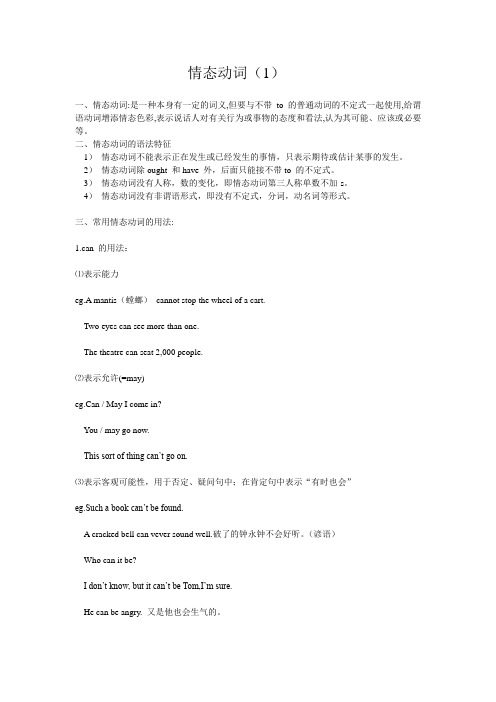
情态动词(1)一、情态动词:是一种本身有一定的词义,但要与不带to的普通动词的不定式一起使用,给谓语动词增添情态色彩,表示说话人对有关行为或事物的态度和看法,认为其可能、应该或必要等。
二、情态动词的语法特征1)情态动词不能表示正在发生或已经发生的事情,只表示期待或估计某事的发生。
2)情态动词除ought 和have 外,后面只能接不带to 的不定式。
3)情态动词没有人称,数的变化,即情态动词第三人称单数不加-s。
4)情态动词没有非谓语形式,即没有不定式,分词,动名词等形式。
三、常用情态动词的用法:1.can 的用法:⑴表示能力eg.A mantis(螳螂)cannot stop the wheel of a cart.Two eyes can see more than one.The theatre can seat 2,000 people.⑵表示允许(=may)eg.Can / May I come in?You / may go now.This sort of thing can’t go on.⑶表示客观可能性,用于否定、疑问句中;在肯定句中表示“有时也会”eg.Such a book can’t be found.A cracked bell can vever sound well.破了的钟永钟不会好听。
(谚语)Who can it be?I don’t know, but it can’t be Tom,I’m sure.He can be angry. 又是他也会生气的。
⑷表示惊异、怀疑、不相信等态度,主要用于否定、疑问或惊叹句中eg.No,no,this can’t be true.What can he mean?How can you be so careless?*在表示能力时,be able to 等于can ,但是前者有更多的时态形式,并且强调能而做到,后者只表示能力是否达到eg.I’m sorry I haven’t been able to answer your letter.She sai she had never been able to come earlier.She said she would be able to persuaded her husband to abandon smoking.2.could的用法⑴作为can 的过去式形式,表示过去的能力、可能性、允许等eg.He said too fast. Could you catch what he said?Before liberation,few workers could support their families.She asked whether she could take the book out of the room.⑵比较委婉的提出问题或陈述看法,这时没有时间上的差别eg.Could you tell me the way to the Children’s Palace?I could come earlier if necessary.I’m afraid I couldn’t give you an answer today.⑶用在虚拟语气中构成谓语eg.I would help you if I could.If you had tried harder you could have overcome the difficulties.We would be much obliged if you could send us a sample.3.may的用法⑴询问或说明一件事可不可以做,即表示许可eg.May I trouble you with a question?You may take this seat if you like.May I smoke here?Yes, ple ase. / No,you mustn’t.Please may not pick flowers in the garden.⑵表示可能性/ 推测eg.He may be busy now.A fool may give a wise man councel. 傻子也能改聪明人出主意。
小学英语语法知识点总结:情态动词

我们现在学过的情态动词有:can, could, will, would, may, must, should, shall。
情态动词后动词总是⽤原形。
(不受其他任何条件影响)特征 1)情态动词(modal verb)本⾝有词义,表⽰说话⼈的语⽓或情态,但词义不完全,不能单独⽤作谓语动词,⼀般只能和动词原形⼀起构成谓语动词。
2)情态动词所表⽰的情态有:命令、允诺、请求、拒绝、愿望、愿意、义务、必要、可能、能⼒、敢于、需要等。
3)情态动词(ought除外)和助动词shall,will,should,would⼀样,后⾯的动词不定式⼀般皆不带。
形式变化 1)没有⼈称和数的变化,第三⼈称单数的现在时也⽆变化。
如: I can We can You can You can He They can She can It 2)有些情态动词有过去式,有少数过去式和它的原形相同。
a)有过去式的情态动词有: may -- would can ―― could may―― night shall -- should have to -- had to b)过去式不变的情态动词有: must - must (或had to) ought to - ought to need---need dare - dare(亦可⽤dared) 3)⼤多数情态动词后⾯可⽤动词的进⾏式、完成式和被动形式,如:can(may,must)be doing,can(may,must)have done,can(may,must)be done等。
否定式 情态动词和助动词⼀样,后⾯可直接跟否定词not。
现将情态动词的否定式及其否定式的简略式(简略式⽤于⼝语中)列举如下: shall not--shan‘t [FB:nt] will not---won’t [wEunt] can not-can‘t [kB:nt] must not-mustn’t [5mQsnt] should not-- shouldn‘t would not-- wouldn’t could not-- couldn‘t dare not- daren’t [dZEnt] need not-- needn‘t 在疑问句中的⽤法 情态动词在疑问句中的⽤法和助动词相同。
情态动词讲解学生
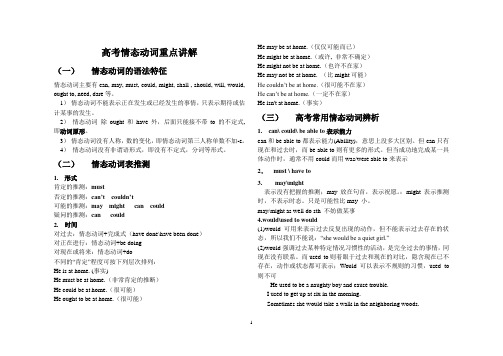
高考情态动词重点讲解(一)情态动词的语法特征情态动词主要有can, may, must, could, might, shall , should, will, would, ought to, need, dare等。
1)情态动词不能表示正在发生或已经发生的事情,只表示期待或估计某事的发生。
2)情态动词除ought 和have 外,后面只能接不带to 的不定式,即动词原形。
3)情态动词没有人称,数的变化,即情态动词第三人称单数不加-s。
4)情态动词没有非谓语形式,即没有不定式,分词等形式。
(二)情态动词表推测1.形式肯定的推测:must否定的推测:can’t couldn’t可能的推测:may might can could疑问的推测:can could2. 时间对过去:情态动词+完成式(have done\have been done)对正在进行:情态动词+be doing对现在或将来:情态动词+do不同的“肯定”程度可按下列层次排列:He is at home. (事实)He must be at home.(非常肯定的推断)He could be at home.(很可能)He ought to be at home.(很可能)He may be at home.(仅仅可能而已)He might be at home.(或许, 非常不确定)He might not be at home.(也许不在家)He may not be at home. (比might可能)He couldn’t be at home.(很可能不在家)He can’t be at home.(一定不在家)He isn't at home.(事实)(三)高考常用情态动词辨析1.can\ could\ be able to表示能力can和be able to都表示能力(Ability),意思上没多大区别。
但can只有现在和过去时,而be able to则有更多的形式。
情态动词英语语法知识点

情态动词英语语法知识点情态动词,本身有一定的词义,表示语气的单词。
但是不能独立作谓语,只能和动词原形一起构成谓语。
这次小编给大家整理了情态动词英语语法知识点,供大家阅读参考。
1 情态动词的语法特征1) 情态动词不能表示正在发生或已经发生的事情,只表示期待或估计某事的发生。
2) 情态动词除 ought 和 have 外,后面只能接不带 to 的不定式。
3) 情态动词没有人称,数的变化,即情态动词第三人称单数不加-s。
4) 情态动词没有非谓语形式,即没有不定式,分词,等形式。
1 情态动词的语法特征1) 情态动词不能表示正在发生或已经发生的事情,只表示期待或估计某事的发生。
2) 情态动词除 ought 和 have 外,后面只能接不带 to 的不定式。
3) 情态动词没有人称,数的变化,即情态动词第三人称单数不加-s。
4) 情态动词没有非谓语形式,即没有不定式,分词,等形式。
2 比较 can 和 be able to1)can could 表示能力;可能 (过去时用 could),只用于现在式和过去式(could)。
be able to 可以用于各种时态。
They will be able to tell you the news soon. 他很快就能告诉你消息了。
2)只用 be able toa. 位于助动词后。
b. 情态动词后。
c. 表示过去某时刻动作时。
d. 用于句首表示条件。
e. 表示成功地做了某事时,只能用 was/were able to,不能用 could。
He was able to flee Europe before the war broke out. = He managed to flee Europe before the war broke out.注意:could 不表示时态1)提出委婉的请求, (注意在回答中不可用 could)。
--- Could I have the television on?--- Yes, you can. / No, you can't.2)在否定,疑问句中表示推测或怀疑。
情态动词(教师)

情态动词编写人:何春霞一、情态动词的语法特征1.情态动词不能表示正在发生或已经发生的事情,只表示期待或估计某事的发生。
2.情态动词除ought 和have 外,后面只能接不带to 的不定式。
3.情态动词没有人称、数的变化,即情态动词第三人称单数不加-s。
4.情态动词没有非谓语形式,即没有不定式,分词等形式。
二.情态动词的基本用法(1)can、be able to 和could①can和be able to都表示能力,意思上没多大区别。
但can只有现在和过去时,而be able to有更多的形式。
但当成功地完成某一具体动作时,通常不用could而用was/were able to表示。
这时was/were able to 相当于managed to,表示经过一番努力,终于能够完成某事。
如:Can you use chopsticks? The wounded man was able to get to the village and was saved in the end.②can和could:can和could都可以表示能力、技能、许可、建议、请求和(客观的理论的)可能性。
但比较委婉客气地提出问题或陈述看法,一般用could,回答时则用can。
如:Could you help me carry the bag? Can I help you? Accidents can happen on such rainy days. 注意:位于助动词或情态动词后,只能用be able to .I haven’t been able to read that report yet. I ought to be able to live on my salary.(2)may/might①may/might表示可能,但may比might可能性大。
如:Peter may come with us tonight, but he isn’t sure yet. (实际的可能性)—Why isn’t he in class?—He may be sick.(生病的可能性较大) / He might be sick.(生病的可能性较小)②may/might表示允许或请求;表示没有把握的推测;may用于现在时或将来时,might常用在间接引语中表过去时,但might也可用于现在时间,表示比较委婉的语气,回答用may。
语法篇专题情态动词和虚拟语气

用法
例句
can和could
表示能力
He can speak English better than you.
表示请求 或允诺?
You can have the book when I have finished it. Could you come again tomorrow?
表示客观可能性
should have done
过去本来应该……,而实际上没有……
The plant is dead. Maybe I should have given it more water.
ought to have done
过去本该……,而未……
You ought to have given him more help.
专题八 情态动词和虚拟语气
情态动词
一、情态动词 定义:情态动词是一种本身具有一定词义,但要与动词原形及其被动语态一起使用的词。它给谓语动词增添情态色彩,表示说话人对有关行为或事物的态度和看法,认为其可能、应该或必要等。 二、情态动词的特点 情态动词无人称和数的变化, 情态动词后面跟的动词需用原形,否定式构成是在情态动词后面加“not”。 个别情态动词有现在式和过去式两种形式, 过去式用来表达更加客气, 委婉的语气, 时态性不强, 可用于过去,现在或将来。情态动词属于非及物动词,故没有被动语态。
三、情态动词的语法特征 (1) 情态动词不能表示正在发生或已经发生的事情,只表示期待或估计某事的发生。 (2) 情态动词除ought 和have 外,后面只能接不带to 的不定式。 (3) 情态动词没有人称和数的变化,即其第三人称单数不加s。 (4) 情态动词没有非限定形式,即没有不定式,分词形式,也没有相应的动名词。 四、情态动词的基本用法
情态动词

2) could的主要用法是:
A. could 是can的过去式, 表示与过去 有关
的能力和推测:
e.g. We all knew that the young man couldn’t be a doctor.
2. 在疑问句中用于第二人称,提出请求 或询问。
eg: If you want help, let me know, will you? 如果你需要帮助,让我知道,好吗? Will you type this, please? 请打印这个, 好吗? Won't you sit down? 请坐下, 好吗?
eg. The girl can dance very well.
B. 表示说话的推测﹑事物的可能性等:
eg. Can the news be true?
C. 在口语中, can可以表示请求或允许:
eg. Can I sit here?
1.
can表示“能够”时与短语be able to同义,但can只用
B. could可以代替can表示请求, 但语气较 can客气、委婉:
e.g. Could you lend me your dictionary? Could I use your bike?
3) can和could接动词的完成形式,表示可能 已经做某事。can用在否定和疑问句中, 表 示不相信、怀疑等态度。
表必要
否定式
needn’t
注意点
( 区别 have to)
“必须” “不必” 有时表“偏要”
must
初中英语情态动词专项语法讲解
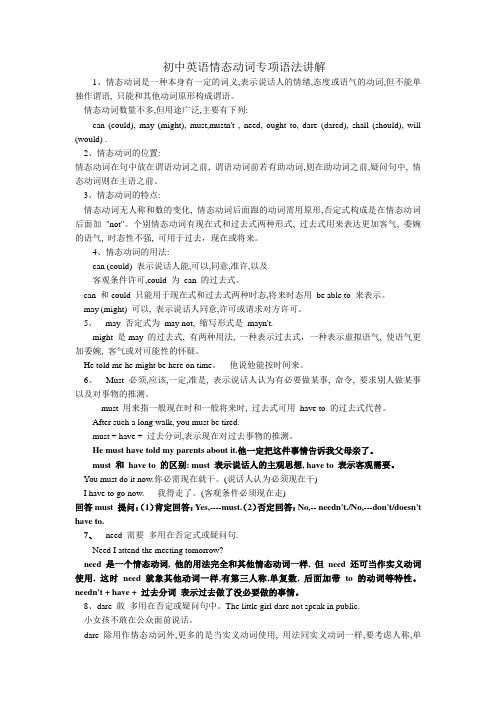
初中英语情态动词专项语法讲解1、情态动词是一种本身有一定的词义,表示说话人的情绪,态度或语气的动词,但不能单独作谓语, 只能和其他动词原形构成谓语。
情态动词数量不多,但用途广泛,主要有下列:can (could), may (might), must,mustn't , need, ought to, dare (dared), shall (should), will (would) .2、情态动词的位置:情态动词在句中放在谓语动词之前, 谓语动词前若有助动词,则在助动词之前,疑问句中, 情态动词则在主语之前。
3、情态动词的特点:情态动词无人称和数的变化, 情态动词后面跟的动词需用原形,否定式构成是在情态动词后面加"not"。
个别情态动词有现在式和过去式两种形式, 过去式用来表达更加客气, 委婉的语气, 时态性不强, 可用于过去,现在或将来。
4、情态动词的用法:can (could) 表示说话人能,可以,同意,准许,以及客观条件许可,could 为can 的过去式。
can 和could 只能用于现在式和过去式两种时态,将来时态用be able to 来表示。
may (might) 可以, 表示说话人同意,许可或请求对方许可。
5、may 否定式为may not, 缩写形式是mayn't.might 是may 的过去式, 有两种用法, 一种表示过去式,一种表示虚拟语气, 使语气更加委婉, 客气或对可能性的怀疑。
He told me he might be here on time。
他说他能按时间来。
6、Must 必须,应该,一定,准是, 表示说话人认为有必要做某事, 命令, 要求别人做某事以及对事物的推测。
must 用来指一般现在时和一般将来时, 过去式可用have to 的过去式代替。
After such a long walk, you must be tired.must + have + 过去分词,表示现在对过去事物的推测。
初中英语语法专题讲座06——情态动词
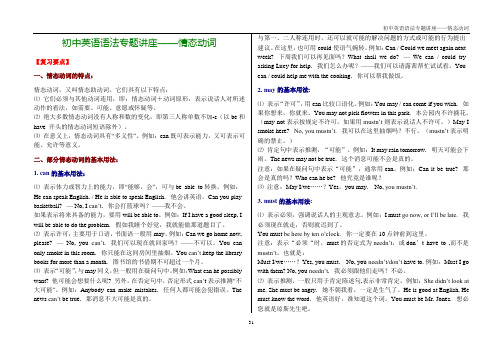
⑵表示许可,主要用于口语,书面语一般用may。例如:Canwe go home now, please? — No, youcan’t.我们可以现在就回家吗?——不可以。Youcanonly smoke in this room.你只能在这间房间里抽烟。Youcan’tkeep the library books for more than a month.图书馆的书借期不可超过一个月。
6.had better的基本用法:
had better常略作’d better。现代语法认为它是一个助动词,因为它后接不带to的动词不定式。had better do sth意思是“最好做某事;还是做某事比较好”。例如:Wehad betterstart at once.我们最好马上出发。You’d betterget some sleep.你最好睡一会儿。You’d better notdo that again.你最好别再做那件事。Whathadwebetterdo now?我们现在怎么做才好呢?Hadn’twebettertell her the truth?我们是否最好不告诉她真相?
8.could, should, would, might表示推测:
①. must多用于肯定句中表示把握性极大的推测,意思为“一定、肯定”。如:You have worked hard all day. You must be tired.你已辛苦工作一整天了,一定累了。The book must be his. His name is on the cover.这本书一定是他的,封面上写着他的名字。
英语中情态动词有哪些 都有哪些用法

英语中情态动词有哪些都有哪些用法
英语中的情态动词是考试一定会考的一个知识点,那幺,英语中情态动词有哪些呢?下面和小编一起来看看吧!
1 英语中有哪些情态动词情态动词(Modal verbs)本身有一定的词义,但是不
能独立作谓语,只能和动词原形一起构成谓语。
英语中的情态动词有十三个:
may, might; can, could; will, would; shall, should; must, need, dare, used to,
ought to.
情态动词的语法特征
1)情态动词不能单独做谓语,除ought 和have 外,后面只能接不带to 的
不定式。
2)情态动词没有人称,数的变化,但有些情态动词,如can、will 也有一般
式和过去式的变化。
3)情态动词的“时态”形式并不是时间区别的主要标志,不少情况下,情态
动词的现在式形式和过去式形式都可用来表示现在时间、过去时间和将来时间。
情态动词属不及物动词,故没有被动语态。
1 情态动词有哪些用法情态动词有can (could), may (might), must, have to,
shall (should, will (would), dare (dared), need (needed), ought to 等。
情态动词
无人称和数的变化;不能单独使用,必须与其后的动词原形构成谓语。
一、can, could
1) 表示能力(体力、知识、技能)。
Can you lift this heavy box?(体力)。
情态动词用法总结

4. should与ought to
1. ought to比should语气更重。两者都用于表劝告、建议。 意为”应该、应当”。但在疑问句中常用should。ought to的否定式为oughtn’t to或ought not to。
Eg: I should help her because she is in trouble. You ought to take care of the baby. Should I open the window? What should we do next?
Eg: 1)Will you lend me your book? 2) Would you like a cup of tea?
2. 用于表示意志或意愿,意为“会,愿意” 。will 指 现在,而 would 指 过去。用于否定句中,表示“不 会、不肯、不乐意”。
Eg: 1) I won’t do that again. 2) They said that they would help us. 3) No matter what I said, he won’t listen to me.
1. can 与could
1.表能力,意为“能,能够”,can指现在,could指过去。
1) Some of us can use the computer now, but we couldn’t last year.
2. 表示推测,意为“可能”“或许”,用于疑问句或 否定句,can’t和couldn’t意为“不可能”。
却干了
Eg: You should have invited me to the party yesterday. You are right. I Should have thought of that. You shouldn’t have eaten all the cakes in one day.
初中英语语法大全情态动词
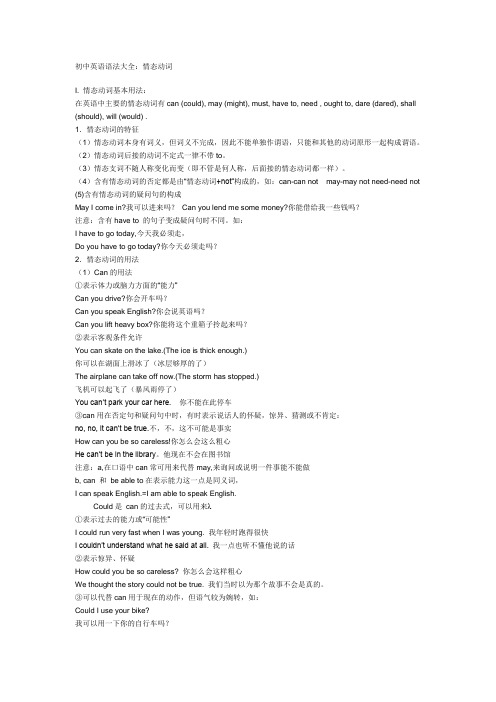
初中英语语法大全:情态动词I. 情态动词基本用法:在英语中主要的情态动词有can (could), may (might), must, have to, need , ought to, dare (dared), shall (should), will (would) .1.情态动词的特征(1)情态动词本身有词义,但词义不完成,因此不能单独作谓语,只能和其他的动词原形一起构成谓语。
(2)情态动词后接的动词不定式一律不带to。
(3)情态支词不随人称变化而变(即不管是何人称,后面接的情态动词都一样)。
(4)含有情态动词的否定都是由“情态动词+not”构成的,如:can-can not may-may not need-need not (5)含有情态动词的疑问句的构成May I come in?我可以进来吗?Can you lend me some money?你能借给我一些钱吗?注意:含有have to 的句子变成疑问句时不同。
如:I have to go today,今天我必须走,Do you have to go today?你今天必须走吗?2.情态动词的用法(1)Can的用法①表示体力或脑力方面的“能力”Can you drive?你会开车吗?Can you speak English?你会说英语吗?Can you lift heavy box?你能将这个重箱子拎起来吗?②表示客观条件允许You can skate on the lake.(The ice is thick enough.)你可以在湖面上滑冰了(冰层够厚的了)The airplane can take off now.(The storm has stopped.)飞机可以起飞了(暴风雨停了)You can’t park your car here.你不能在此停车③can用在否定句和疑问句中时,有时表示说话人的怀疑,惊异、猜测或不肯定:no, no, it can’t be true.不,不,这不可能是事实How can you be so careless!你怎么会这么粗心He can’t be in the library。
九年级英语上册unit8知识要点

九年级英语上册Unit8 It must belong to Carla.一、语法:情态动词表示推测的用法Ⅰ、情态动词的基本用法:(一)、情态动词的语法特征:①情态动词有具体的词义。
②情态动词没有人称和数的变化。
③情态动词后必须跟动词原形,两者一起构成谓语动词。
④一般疑问句提前边,否定句在后直接加not.(二)、情态动词的用法:1、can / can not用法1)表示能力(会)Mary can speak English, but she can not speak French. 玛丽会讲英语,但不会讲法语。
Can you lift this heavy box? 你能搬起这个重箱子吗?Can you skate? 你会滑冰吗?2)表示允许(可以)Can I use your dictionary? 我能用一下你的词典吗?-- Can I go home now?-- Yes, you can. / No, you can’t.2、could的用法1)是can 的过去式;表示过去的能力;He could ride a bike at the age of five. 在他五岁时就能骑自行车。
2)用于婉转语气,多用于问句。
“能,可以”Could you please clean the room?---- Could I come to see you tomorrow? ---- Yes, you can. ( No, you can’t. )此处could 不是过去式,只是语气更委婉,答语中不能用could和couldn’t,要用can 和can’t。
3、may、might的用法1)表示请求和允许(可以), 比can 正式.May I come in?He may come if he likes.may的一般疑问句,其否定回答用can’t 或mustn’t。
--May I go home now? --Yes, you may. / Sure. / Yes, please.-- No, you can’t./ mustn’t.2)might①是may 的过去式。
2018年高中英语狂K语法——句法篇:六、情态动词 Word版含解析

1 情态动词的语法特征1) 情态动词不能表示正在发生或已经发生的事情,只表示期待或估计某事的发生;2) 情态动词除ought 和have 外,后面只能接不带to 的不定式;3) 情态动词没有人称,数的变化,即情态动词第三人称单数不加-s;4) 情态动词后加动词原形。
2 比较can和be able to1) 表示主语的“能力”时,can与be able to属同义词,两者可以通用。
但从语法上严格来说,can属于情态助动词,它只有现在和过去两种时态形式;而be able to属于半助动词,它有较多的时态形式,表达将来的“能力”时,一般用be able to。
One day people will be able to travel to the moon.有朝一日,人们会到月球去旅行的。
2) 只用be able to的情况:a. 位于助动词后;b. 情态动词后;c. 表示过去某时刻动作时;d. 用于句首表示条件。
注意:could有时不表示时态1) 提出委婉的请求,(注意在回答中不可用could)。
例如:— Could I have the television on? 我能看电视吗?—Yes, you can. / No, you can’t. 可以/不可以。
2) 在否定句、疑问句中表示推测或怀疑。
例如:He couldn’t be a bad man.他不大可能是坏人。
3 比较may和might1) 表示允许或请求;表示没有把握的推测;may放在句首,表示祝愿。
例如:May God bless you! 愿上帝保佑你!He might be at home. 他可能在家。
注意:might表示推测时,不表示时态,只是可能性比may小。
2) may/might as well,后面接不带to的不定式,意为“不妨”。
例如:If that is the case, we may as well try.如果情况确实如此,我们不妨试一试。
情态动词

They should be home by now,I think.(possibility) 我想他们现在可能到家了。 5)should还可以用于虚拟语气中, 表示与现在或过去事实相反的假定。 如: You should have come back early. 你本该早点儿回来的。
5. must 和 have to
You should keep your promise. (advice) 3)should 作为情态动词,可以表 示谦逊、客气、委婉之意,译为 “可……”、“倒……”。如: I should say that it would be better to try it again. 4)should 作为情态动词,可以用 来表示有较大可能实现的猜测、推论, 通常译为“可能”、“总该……吧”, 相当于 be expected to。如:
三、类型
纯粹的情态动词: can/could, may/might, ought to, must 情态动词+实义动词: need, dare/dared 情态动词+助动词: shall/should, will/would 类(相当)情态动词: have to, used to
四、情态动词的否定式
The road may be blocked. 这条路可能不通。 The road can be blocked. 这条路有可能不通。 注意:在疑问句中,表示可能性 用can。如: Where can he be? ③表示祝愿,但语气较正式 (blessing)。如: May you succeed! May you have a good journey!
注意:have to的三人称单数形式是has to,过去式had to。
情态动词用法总结

tomorrow afternoon. ---- They __B___ be ready by 一二 00
A. can B. should
C. might D. need
c 三. We ______ last night, but we went to the concert
instead.
A. must have studied B. might study
四. should与ought to
一. ought to比should语气更重.两者都用于表劝告、建议. 意为”应该、应当”.但在疑问句中常用should.ought to 的否定式为oughtn’t to或ought not to.
Eg I should help her because she is in trouble. You ought to take care of the baby. Should I open the window? What should we do next?
A. might
B. should
C. can
D. will
二.Peter _B____ come with us tonight,
but he isn’t very sure yet.
A. must
B. may
C. can
D. will
三. will 与would
一. 用于第二人称的疑问句中,表“请求、建议”等,用 would 比用will 委婉,客气些
A. should B. will
C. need D. must
二. When he was there, he_A_____ go to that coffee shop at th
- 1、下载文档前请自行甄别文档内容的完整性,平台不提供额外的编辑、内容补充、找答案等附加服务。
- 2、"仅部分预览"的文档,不可在线预览部分如存在完整性等问题,可反馈申请退款(可完整预览的文档不适用该条件!)。
- 3、如文档侵犯您的权益,请联系客服反馈,我们会尽快为您处理(人工客服工作时间:9:00-18:30)。
情态动词的语法特征以及5大考点
一、情态动词的语法特征
1.情态动词表示说话人对所做动作的观点或态度。
如:需要、可能、意愿、怀疑等。
例如:I must go now. 我现在必须得走了。
2.情态动词一般没有人称和数的变化,但是个别情态动词有时态的变化。
例如:can的过去式是could.
3.情态动词不能单独作谓语,后接动词原形共同做谓语。
例如:I can swim. 我会游泳。
4.常见的情态动词有:can, may, must, have to, should, would等。
5.情态动词一般不止一个意思,它的否定式是在情态动词的后面加not,一般疑问句是将情态动词提到句首。
例如:I can’t speak French. 我不会说法语。
Can you speak English?你会说英语吗?
二、考点一can的用法
①表能力
例如:We can do our homework by ourselves.
我们可以自己完成作业。
He can swim well.他游泳很好。
I can play football but I can’t play the piano.
我会踢足球但是我不会弹钢琴。
②表许可
例如:You can watch TV after supper.
晚饭后你可以看电视。
例如:You can’t play basketball in the street.
你不能在街上打篮球。
③表请求
例如:Can you help me with my math?
你能帮我学数学吗?
Could you lend your book to me?你能把你的书借给我吗?注意:could 是can的过去式,但是这里并不表示过去时,而是表示委婉语气。
④表示“不可能……”
情态动词can的否定式,可以用来表示否定的推测,意为“不可能……”。
例如:That can’t be her father, because her father has gone to England.
那人不可能是她爸爸,因为她爸爸已经去英国了。
三、考点二may的用法
①表示请求和允许
例如:May I borrow your bike?我可以借你的自行车吗?
You may go home now. 现在你可以回家了。
②表示推测。
情态动词may表示推测时,意思是“可能(会),或许(会)”。
例如:It may rain tomorrow. 明天可能会下雨。
She may be at home. 她可能在家呢。
③may的过去式
may的过去式为might,语气比may弱。
表示推测时,可能性低于may。
例如:He is away from school. He might be sick.
他离开学校了,可能是他生病了。
④表示希望、祈求、祝愿
may表示希望、祈求、祝愿时,常可译为“祝…,但愿”。
例如:May you have a good time. 祝你过得愉快。
May you be happy! 祝你幸福!
May you succeed! 祝你成功!
四、考点三must的用法
①表必须
情态动词must在肯定句中后跟动词原形,表示“必须”的含义。
例如:You must finish your homework on time.
你必须按时完成作业。
We must return the books on time.
我们必须按时把书归还。
②在否定结构中表“禁止,不许”
例如:You mustn't leave here. 不允许你离开这儿。
You mustn’t s hout in the classroom. 禁止在教室喊叫。
③表推测
must用于肯定句中的推测,意为“一定是……”。
例如:He must be ill. He looks so pale.
他肯定是病了。
他的脸色那么苍白。
The light is on, so he must be at home now.
灯亮着,他现在肯定在家。
五、考点四have to的用法
have to是一个词组,相当于情态动词,表示“不得不,必须”。
一般现在时中,当主语是第三人称单数时,要将have 变成has.
一般过去时中,要将have变成had.
例如:We have to be quiet in the library.
你必须在图书馆保持安静。
She has to finish her homework before she goes home.
她在回家前必须完成作业。
六、考点五情态动词的问答
①由can引起的提问,肯定回答用can,否定回答用can’t.
例如:-Can you open the door?你能打开门吗?
-Yes, I can. 是的,可以。
-No, I can’t. 不,不可以。
②由may引起的提问,肯定回答用may/can, 否定回答用can’t/mustn’t.
例如:-May I open the window?我可以打开窗户吗?
-Yes, you can/ may. 是的,可以。
-No,you can’t /mustn’t. 不,不行/不允许。
③由must引起的提问,肯定回答用must,否定回答用needn’t/ don’t have to.
例如:-Must I finish my homework now?
我现在必须完成作业吗?
-Yes, you must. 是的,必须。
-No, you needn’t / don’t have to. 不,不必。
